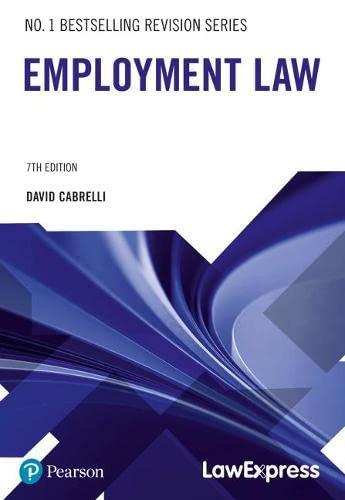Question
Each of the following examples presents a brief summary of the court opinion, followed by a client's fact situation. For each client fact situation, Parts
Each of the following examples presents a brief summary of the court opinion, followed by a client's fact situation. For each client fact situation, Parts A through G, determine the following:
- What are the fact similarities and differences between the court opinion and the client's situation?
- Is the court opinion on point? Why or why not?
- If the opinion is on point, what will the probable decision be in regard to the question raised by the client's facts?
Example 1
Court Opinion: State v. Jones. Mr. Jones, a first-time applicant for general relief funds, was denied relief without a hearing. The denial was based on information in Mr. Jones's application indicating that his income was above the threshold maximum set by the agency regulations. The regulation provides that when an applicant's income, or the financial support provided to an applicant plus income, exceeds $12,000 a year, the individual may be denied general relief funds. The regulation is silent about the right to a hearing.
Mr. Jones's application reflected that the gross income from his two part-time jobs exceeded the maximum allowable income for eligibility by $2,000. He believed there were special circumstances that would allow him to be eligible for general relief. His demand for an appeal hearing to explain his special circumstances was denied.
The court held that the due process clause of the state constitution entitles a first-time applicant for general relief funds to a hearing when special circumstances are alleged. The question in the following three fact situations is whether the client is entitled to a hearing.
Part A
Client's Facts: Tom lives at home with his parents. He has a part-time job. He does not pay rent or utilities. He uses the money from his job to attend school, and he has very little left over. His application for general relief was denied. The written denial stated that the combination of the support provided by his parents and his part-time income exceeded the maximum allowable income. His application for an appeal hearing was denied.
Part B
Client's Facts: In the last session of the state legislature, legislation was passed providing that when applicants for general relief are denied relief based on information provided in the application, they are not entitled to an appeal hearing. The purpose of the legislation is to cut costs.
Mr. Taylor, a first-time applicant for general relief funds, was denied benefits based solely on his application. He believes that he has special circumstances that entitle him to benefits. His request for an appeal hearing was denied.
Part C
Client's Facts: Client has been receiving general relief funds for the past year. Last week, he received notice that his relief would be terminated due to information received from his employer indicating that he had received a raise, and his income is now over the statutory maximum. His request for an appeal hearing on the termination of relief was denied.
Example 2
Court Opinion: Rex v. Ireland. Mr. Rex, the landlord, filed an eviction suit against his tenant, Mr. Ireland.
Mr. Rex served notice of default upon Mr. Ireland by rolling up the notice of default and placing it in Mr. Ireland's mailbox. The mailbox was situated next to the street. Mr. Ireland retrieved the notice the next day. Mr. Ireland, in his defense to the eviction suit, stated that he was not given proper notice of default under the provisions of 55-67-9 of the Landlord/ Tenant Act; therefore, the case should be dismissed. The statute provides that notice of default may be accomplished in one of three ways:
- Delivery by certified mail
- Hand delivery to the individual to be evicted
- Posting at the most public part of the residence
The statute further provides that the court may enter an order of eviction if the notice of default is not responded to within 30 days.
The court, denying the request for dismissal, ruled that the intent of the statute was to ensure that tenants receive notice of default. The court noted that although the method of delivery used by Mr. Rex did not comply with the statute, the intent of the act was accomplished, inasmuch as Mr. Ireland had actual notice of default and was not prejudiced by the improper notice.
The question in the following four fact situations is whether the notice of default is effective.
Part D
Client's Facts: The client is a tenant. The landlord told the client's daughter to inform the tenant that he was in default and, under the terms of the lease, would be evicted if he did not pay or otherwise respond within 30 days. The daughter informed the tenant the next day. Would it make any difference if the daughter informed the tenant after 30 days but before the eviction suit was filed?
Part E
Client's Facts: Client, the tenant, was on vacation when the landlord posted the notice of default on the front door. Client did not return from vacation and learn of the default until after the 30-day default period had passed.
Part F
Client's Facts: Landlord sent the notice of default by regular mail, and the tenant received it.
Part G
Client's Facts: The landlord sent the notice by certified mail, but the client refused to accept it.
Step by Step Solution
There are 3 Steps involved in it
Step: 1

Get Instant Access to Expert-Tailored Solutions
See step-by-step solutions with expert insights and AI powered tools for academic success
Step: 2

Step: 3

Ace Your Homework with AI
Get the answers you need in no time with our AI-driven, step-by-step assistance
Get Started


